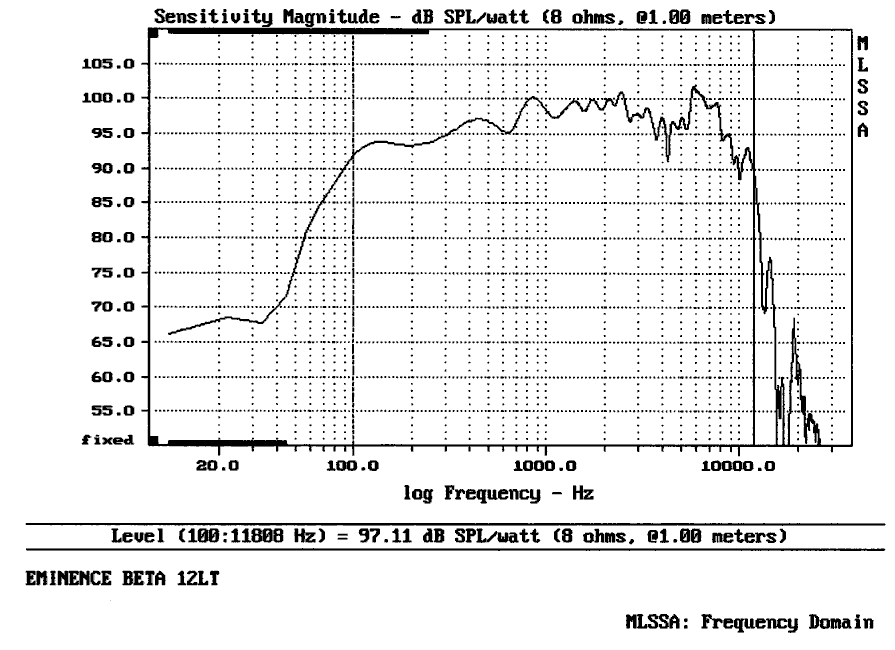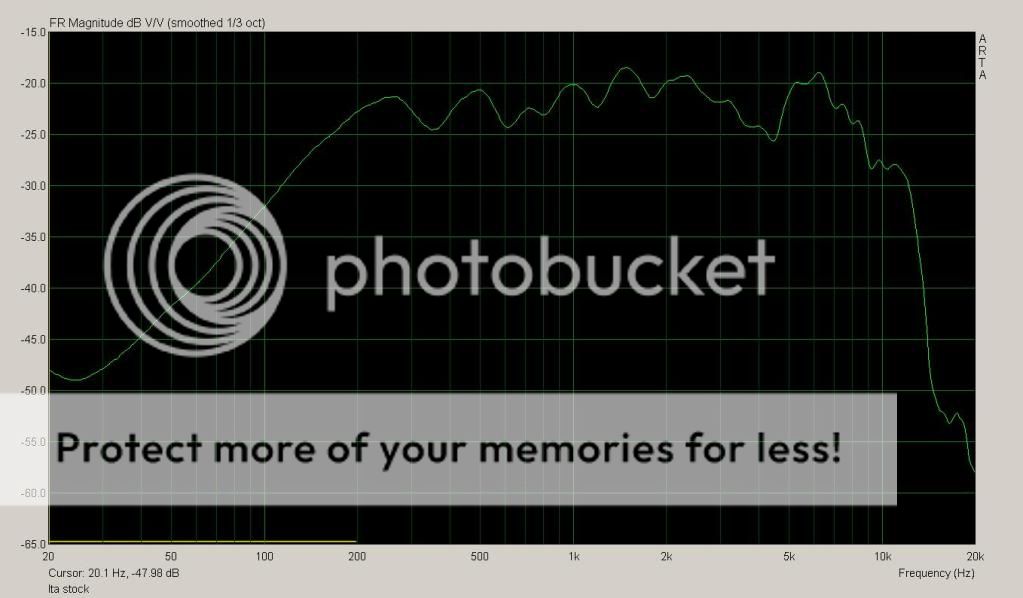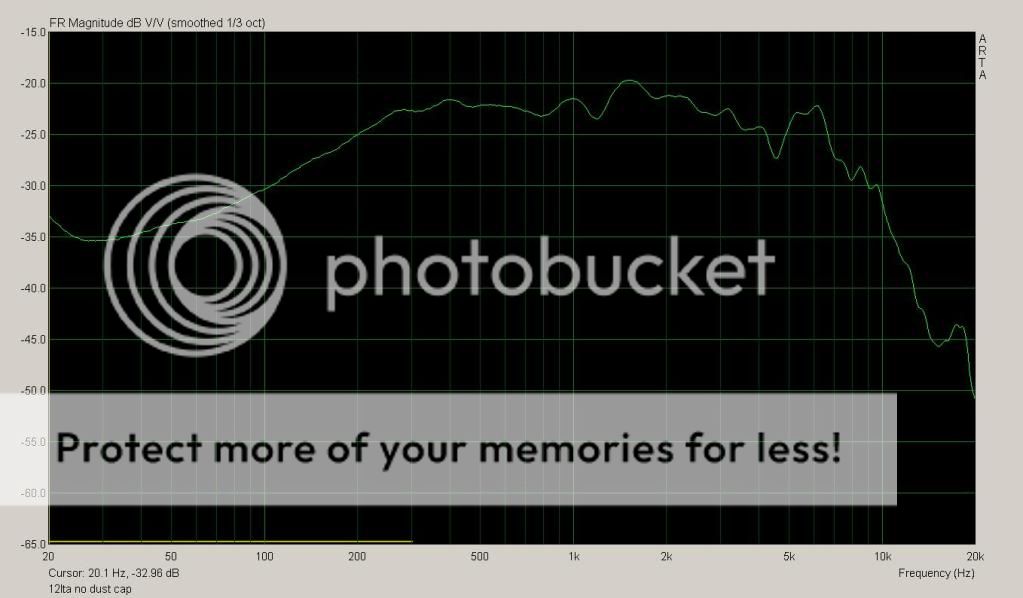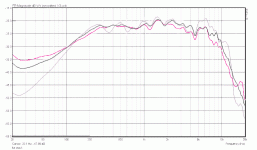I think that at the frequency range under discussion ( i.e. 3-6K) , the type of enclosure / open baffle / whatever will have little impact on the measurements and more importantly, listening impressions.Also I assume the fact the driver wasn't measured previously in the Emken would make some difference?
now it's time for me to blow some smoke - as little faith as I may place in simple on axis FR measures to be reliable predictors of what you'll hear in the real world, (and this one is a real roller coaster ride) I'd imagine the almost 6dB trough, almost a full octave wide ( approx 3000 to 6000), and right at the top end of a critical "telephone" bandwidth would have more effect than the smaller couple at approx 1200 and 1800.From my understanding 'high q' means the short freq range the 4k drop falls and rises over, instead of a broad slow decay. Is that correct?
as for mediation, the notches would appear to be symmetrical and wide enough to be amenable to delicate EQ
the almost 6dB trough, almost a full octave wide ( approx 3000 to 6000), and right at the top end of a critical "telephone" bandwidth would have more effect than the smaller couple at approx 1200 and 1800.
Are we looking at the same FR plot Chris? Third down in JRKO's link. With the phase plug the dip/peak 4khz/6khz combo is really smoothed out. Take out the hill top from 1000hz to 3000hz and it would make it even smoother.
Are we looking at the same FR plot Chris? Third down in JRKO's link. With the phase plug the dip/peak 4khz/6khz combo is really smoothed out. Take out the hill top from 1000hz to 3000hz and it would make it even smoother.
Apparently not, I'm looking at both Eminence's graph for bone stock:
http://www.eminence.com/pdf/Beta_12LTA.pdf
and another measure posted a few pages back on this thread;

and the first 3 of series of db6546's posted ARTA measures that more or less followed our own sessions so far (i.e. from bone stock to dustcap-ectomy to rudimentary but dissimilar phase plug), none of which I see as completely mitigating the notch in question



of course the more of this discussion before you actually hear them, the harder it might be to form an honest impression - I think that the more one thinks about what you'll be hearing, the less you "hear" - but that's just me being a silly bugger
, but will leave my judgement to what I hear. You can be sure of that.
yah - confirmation bias never happens in this hobby
(I've only been guilty of that 99.99% of the time during my 45 yrs of listening )
Thanks for that one Dave. Really shows the differences those mods make.
The plug really smoothes out a lot of the raggedness. I wonder what differences a coat of something and enABL treatment will make, not only to the sound but also to the graph.
well, I've yet to hear a driver on which this type of treatment didn't help in a lot of areas, but don't wonder out loud as to how differently they might measure
oops, too late
I wonder what differences a coat of something and enABL treatment will make, not only to the sound but also to the graph.
utterly transformed my Fane thing into something completely different. the mod podge treatment or even the drastic change the phase plug caused really doesn't compare to what EnABL has just done. i would definitely recommend you take the plunge on one of your drivers. if it all goes wrong its not the most expensive mistake you could make but the risk is easily worth the reward.
Last edited:
6 in one, half dozen in the other. I prefer to cut rather than boost.
Don't worry, I like squiggles, but will leave my judgement to what I hear. You can be sure of that.
Ditto.
Yeah, when I was actively building, response measurements were tedious to do and typically just at every 10 Hz resolution off a RCA tone record unless one had thousands [in 1970's $$$] for measuring equipment, so if it sounded good, it was good; and as it turned out, I managed to keep it near enough to +/- 3 dB from ~ 40 Hz to at least 12.5 kHz if a couple of more recent builds that were later measured with MLSSA are any indication.
GM
Don't worry, I like squiggles, but will leave my judgement to what I hear. You can be sure of that.
well, I've yet to hear a driver on which this type of treatment didn't help in a lot of areas, but don't wonder out loud as to how differently they might measure
oops, too late
Yeah my ears are the final arbiter but when they hear something and can't decide if its correct or not (ie the dry sound now 'corrected' by a 4k lift) squiggles lead the way.
I guess its an untrained ear or just not having heard a system that is close or dead on 'ideal'
...doesn't compare to what EnABL has just done
I read your notes with interest. I think it 'always' makes for an improvement so will eventually get there. As I'm a bit budget limited I like to see what happens when Dave & Chris try it on their pair first -

I read your notes with interest. I think it 'always' makes for an improvement so will eventually get there. As I'm a bit budget limited I like to see what happens when Dave & Chris try it on their pair first -OMG I think I might be afraid of the dots

they can be quite scary would seem. did you see what happened when i flew solo and added an extra few rings without Bud first checking?
http://www.diyaudio.com/forums/multi-way/119676-enabl-listening-impressions-techniques-95.html
seemingly i opened the gates to hell with 20 little white dots :S
moral of the story, it does actually work when you follow the guidance of Bud, it can actually cause a torrent of problems if you dont.
but when they hear something and can't decide if its correct or not (ie the dry sound now 'corrected' by a 4k lift) squiggles lead the way.
I think some people miss out on this aspect of measurements (I'm looking at you Chris
Ok I've added another 1.5uF to the FT17H to make 2.5uF in total. In short my head has snapped up on a big number of tracks in surprise at the sound. Much more bite! Vocals massively better - basically jumped off the seat when I stumbled onto a 'The Answer' by Sarah McLaughlin - Cat was NOT impressed
2.5uF makes for an 8kHz crossover point and a 1st order 6dB slope if I understand correctly. With that shallow a slope am I in danger of hitting Fostex's recommended crossover point 5kHz, or more to the point the cut off freq. (I assume resonance point) of 2.6kHz at any sort of volume?
I know that Dave & Chris will be coming from many other designs and can be more objective. I'm coming from subjective position with only a pair of Minimus 7's and a pair of Kef Uni-Q for comparison. And I liked the Emken better before I found out I forgot about the crossover. It just keeps getting better as far as I'm concerned
2.5uF makes for an 8kHz crossover point and a 1st order 6dB slope if I understand correctly. With that shallow a slope am I in danger of hitting Fostex's recommended crossover point 5kHz, or more to the point the cut off freq. (I assume resonance point) of 2.6kHz at any sort of volume?
I know that Dave & Chris will be coming from many other designs and can be more objective. I'm coming from subjective position with only a pair of Minimus 7's and a pair of Kef Uni-Q for comparison. And I liked the Emken better before I found out I forgot about the crossover. It just keeps getting better as far as I'm concerned
I just took another look at the spec sheet. The resonance impedance spike is hard to make out, but looks fairly benign. You're probably ok.
You might want to try two things just for fun.
Add a 0.25 to 0.35mH shunt coil after the cap.
Reverse polarity (try with and without coil).
Part of the problem with such high and shallow cross overs, is there can be major phase cancellation due to acoustic offset differences. Even on my 950hz cross over, I'm flipping the phase depending on the filter I'm using because my horn is a little deeper than my woofer. Shallow/slow first order slopes create these phase issues over a much wider bandwidth than a multi-order slope will. So it's something to try.
You might want to try two things just for fun.
Add a 0.25 to 0.35mH shunt coil after the cap.
Reverse polarity (try with and without coil).
Part of the problem with such high and shallow cross overs, is there can be major phase cancellation due to acoustic offset differences. Even on my 950hz cross over, I'm flipping the phase depending on the filter I'm using because my horn is a little deeper than my woofer. Shallow/slow first order slopes create these phase issues over a much wider bandwidth than a multi-order slope will. So it's something to try.
Cool to hear about the Blackbirds jrko, we've got 2 pair of Gold Finches nesting with young this year. I see both come and go from my listening chair - 1 pair in my porch and the other in the half-gable......
No EmKens here yet, I guess the good man himself is still working on the revisions.
Just out of interest, what's the measurements of your room?
No EmKens here yet, I guess the good man himself is still working on the revisions.
Just out of interest, what's the measurements of your room?
- Status
- This old topic is closed. If you want to reopen this topic, contact a moderator using the "Report Post" button.
- Home
- Loudspeakers
- Full Range
- Ladies & Gentlemen - The Emken
